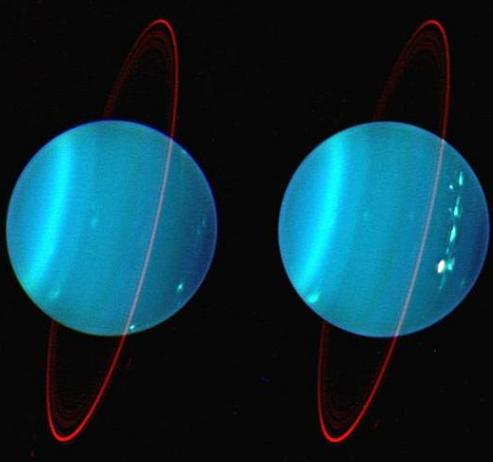The images, taken from the Keck Telescope in Hawaii, provided a glimpse into one of the most enigmatic climate systems in the Solar System.

New images of the planet Uranus reveal more diversity in cloud formations than previously seen.
The images, taken from the Keck Telescope in Hawaii, provided a glimpse into one of the most enigmatic climate systems in the Solar System. This was announced on Thursday at the conference of the Division of Planetary Sciences of the American Astronomical Society.
"The cloud formations range from small to large, from fading clouds to new and bright clouds, from clouds that develop quickly to stable systems that last for years. ” said Lawrence Sarumowski of the Center for Space Science and Engineering at the University of Wisconsin-Madison.
A large storm in the Northern Hemisphere has spanned five degrees of latitude for several years. Such anomalous behavior has not been previously recognized on Uranus says Sromovsky. "It is similar to the storm we saw on Neptune, but there its movement is faster."
Samorowski added that there is no surprise in finding drifting cloud formations in latitudes, but the models do not predict the movement. "We don't know what causes the clouds to return to the starting point." said.
The images also reveal a long, narrow complex of cloud formations that is, as far as is known, the largest group of atmospheric formations ever seen on the planet. The formations were observed in the northern hemisphere, the complex which is almost 30 thousand km long completely disintegrated within a month. These dynamic systems develop in the northern latitudes and move to higher latitudes, depleting their energy and tools relatively quickly." Says Sromovsky.
The cloud formations help scientists define wind patterns and predict the movement of large storm systems that pass across the solar system's second blue planet.
The large and long-lived formations on Uranus originate from hurricane-like winds as we saw on Neptune," said Sromovsky, "even it is unlikely that they are as violent as those that frequently hit Florida, for example.
Hurricanes on Earth get their energy from tropical waters and disappear as they ascend northward within the Atlantic Ocean or as they make landfall. Uranus is 19 times farther from the Sun than Earth and has much less solar energy to drive the process. The storms on Uranus survive because the atmosphere there is much smoother. It therefore provides less atmospheric resistance that helps storms on Earth release their energy.
"The temperature differences are much less sharp and there is very little energy to drive the weather on Uranus" says Stromovsky. Whatever is there lubricates the storms to the same extent, it should be an environment where the coefficient of friction is extremely low."
